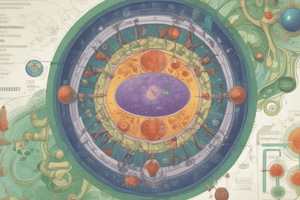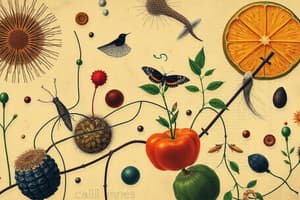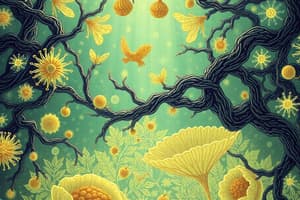Podcast
Questions and Answers
Which cell structure is responsible for producing ATP through cellular respiration?
Which cell structure is responsible for producing ATP through cellular respiration?
- Ribosomes
- Endoplasmic Reticulum
- Nucleus
- Mitochondria (correct)
Ribosomes are responsible for modifying and packaging proteins and lipids.
Ribosomes are responsible for modifying and packaging proteins and lipids.
False (B)
What is the main function of lysosomes within a cell?
What is the main function of lysosomes within a cell?
Digest cellular waste
The cell structure that regulates what enters and exits the cell is the ______.
The cell structure that regulates what enters and exits the cell is the ______.
Match the following cell structures with their functions:
Match the following cell structures with their functions:
Which of the following cell structures is exclusively found in plant cells and is the site of photosynthesis?
Which of the following cell structures is exclusively found in plant cells and is the site of photosynthesis?
Vacuoles primarily function to produce proteins within the cell.
Vacuoles primarily function to produce proteins within the cell.
What type of molecule is primarily stored within vacuoles?
What type of molecule is primarily stored within vacuoles?
The gel-like fluid inside the cell where many chemical reactions occur is called the _______.
The gel-like fluid inside the cell where many chemical reactions occur is called the _______.
Which of these nutrients interacts with the nucleus for DNA synthesis?
Which of these nutrients interacts with the nucleus for DNA synthesis?
The cell membrane is primarily composed of carbohydrates.
The cell membrane is primarily composed of carbohydrates.
What is the process that occurs in the cytoplasm to break down glucose?
What is the process that occurs in the cytoplasm to break down glucose?
_______ is a mineral used by chloroplasts for photosynthesis.
_______ is a mineral used by chloroplasts for photosynthesis.
Which minerals are crucial for maintaining ion balance in nerve and muscle cells, a function supported by the cell membrane?
Which minerals are crucial for maintaining ion balance in nerve and muscle cells, a function supported by the cell membrane?
The Endoplasmic Reticulum interacts with nutrients such as carbon dioxide and water to perform its functions.
The Endoplasmic Reticulum interacts with nutrients such as carbon dioxide and water to perform its functions.
Which of the following is a function of the Endoplasmic Reticulum (ER)?
Which of the following is a function of the Endoplasmic Reticulum (ER)?
What materials will the cell membrane allow to be transported in/out of the cell?
What materials will the cell membrane allow to be transported in/out of the cell?
_______ is the process that ribosomes use to make proteins.
_______ is the process that ribosomes use to make proteins.
Which of these vitamins/minerals do not interact with ribosomes?
Which of these vitamins/minerals do not interact with ribosomes?
Lysosomes use enzymes made of lipids.
Lysosomes use enzymes made of lipids.
Flashcards
Nucleus
Nucleus
Contains DNA and controls cell activities.
Mitochondria
Mitochondria
Produces ATP through cellular respiration.
Ribosomes
Ribosomes
Responsible for protein synthesis.
Endoplasmic Reticulum (ER)
Endoplasmic Reticulum (ER)
Signup and view all the flashcards
Lysosomes
Lysosomes
Signup and view all the flashcards
Vacuoles
Vacuoles
Signup and view all the flashcards
Cytoplasm
Cytoplasm
Signup and view all the flashcards
Chloroplasts
Chloroplasts
Signup and view all the flashcards
Cell Membrane
Cell Membrane
Signup and view all the flashcards
Study Notes
- Cell structures have specific functions and nutrient interactions
Nucleus
- Contains DNA
- Controls cell activities
- Interacts with proteins (for enzymes and histones)
- Interacts with vitamins (B12 a1 folate for DNA synthesis)/2inc
Mitochondria
- Produces ATP through cellular respiration
- Interacts with carbohydrates, as the main fuel source
- Interacts with Lipids (fatty acids) during fasting or low-carb states
- Interacts with proteins (amino acids) when carbs/lipids are low
- Interacts with Vitamins/minerals: B1, B2, B3, and Iron for ATP production
Ribosomes
- Facilitate protein synthesis
- Translate mRNA into proteins
- Interacts with proteins, carbohydrates and r sviic e/mtein-ium for ribosomal function
Endoplasmic Reticulum (ER)
- Modifies, packages, and ships proteins and lipids
Lysosomes
- Digests cellular waste, damaged organelles, and macromolecules
- Interacts with proteins and lipids
- Interacts with Vitamin E for membrane stability, recycling nutrients
Vacuoles
- Stores nutrients, waste, and water
- Requires enzymes made of proteins
Cytoplasm
- Gel-like fluid where many reactions occur
- Site for glycolysis (glucose breakdown)
- Contains dissolved nutrients, enzymes, and ions
Chloroplasts (plant cells only)
- Site of photosynthesis
- Makes glucose from sunlight
- Requires carbon dioxide, water, and light
- Interacts with minerals like magnesium in chlorophyll
Cell Membrane
- Regulates what enters and exits the cell
- Composed of lipids and proteins
- Uses minerals like sodium, potassium, and calcium to maintain ion balance, which is important in nerve and muscle cells
- Allows the transport of glucose, amino acids, and fatty acids
Studying That Suits You
Use AI to generate personalized quizzes and flashcards to suit your learning preferences.




